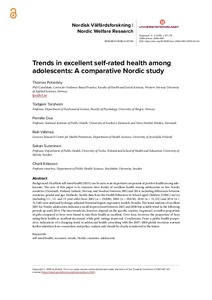Trends in excellent self-rated health among adolescents: A comparative Nordic study
Thomas Potrebny; Torbjørn Torsheim; Pernille Due; Raili Välimaa; Sakari Suominen; Charli Eriksson
https://urn.fi/URN:NBN:fi-fe2021042824436
Tiivistelmä
Background: Excellent self-rated health (SRH) can be seen as an important component of positive health among adolescents. The aim of this paper is to examine time trends of excellent health among adolescents in five Nordic
countries (Denmark, Finland, Iceland, Norway and Sweden) between 2002 and 2014, including differences between
countries, gender and age. Methods: Nordic data from the Health Behaviour in School-aged Children (HBSC) survey
(including 11-, 13- and 15-year-olds) from 2002 (n = 19,009), 2006 (n = 29,656), 2010 (n = 33,232) and 2014 (n =
31,540) were analysed by design-adjusted binomial logistic regression models. Results: The trend analysis of excellent
SRH for Nordic adolescents indicates a small improvement between 2002 and 2006 but a stable trend in the following
periods up until 2014. The time trends do, however, depend on the specific country. In general, a smaller proportion
of girls compared to boys were found to rate their health as excellent. Over time, however, the proportion of boys
rating their health as excellent decreased, while girls’ ratings improved. Conclusions: From a public health perspective, indications of a changing trend in adolescent health coinciding with the 2007–2008 global recession warrant
further attention from researchers and policy-makers and should be closely monitored in the future.
Kokoelmat
- Rinnakkaistallenteet [27094]
